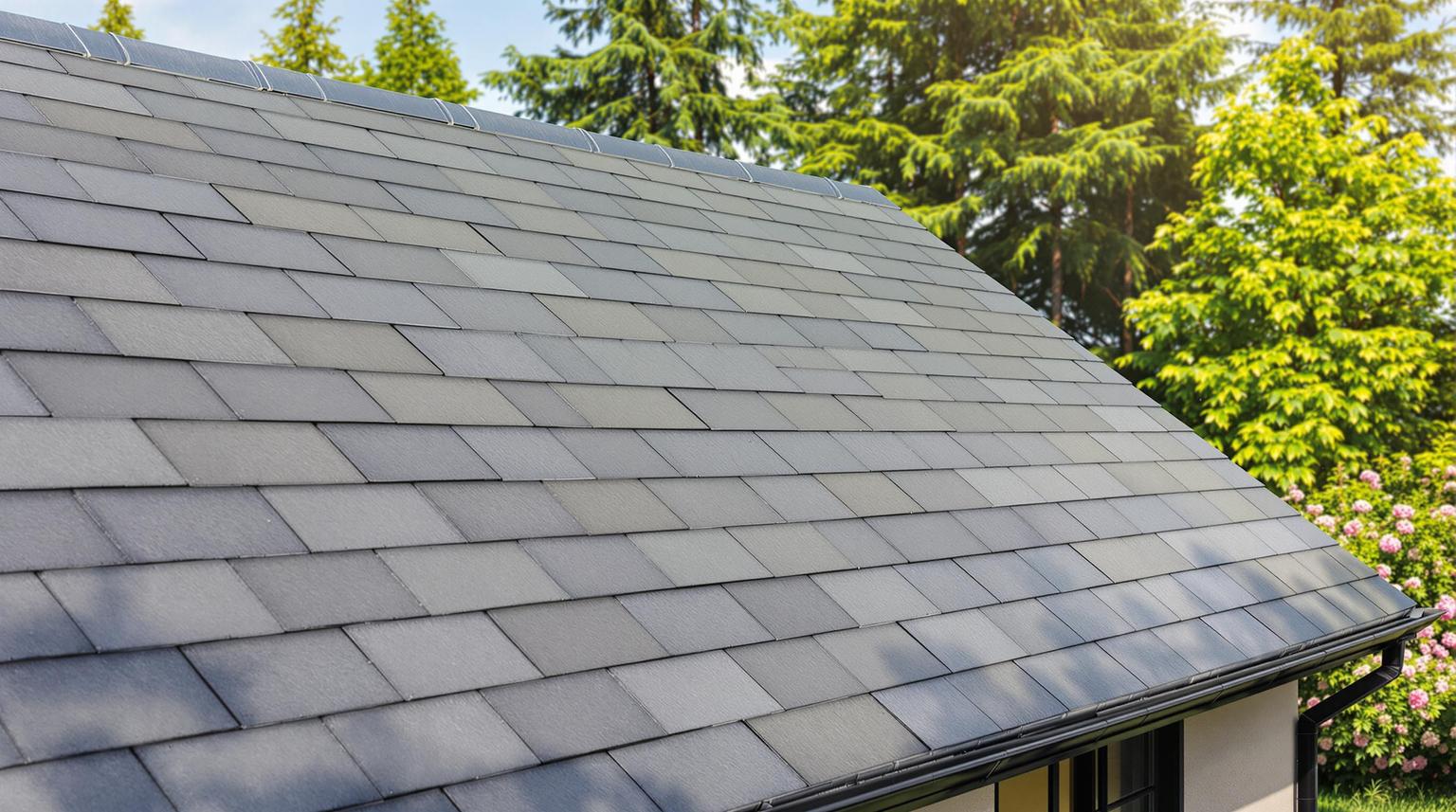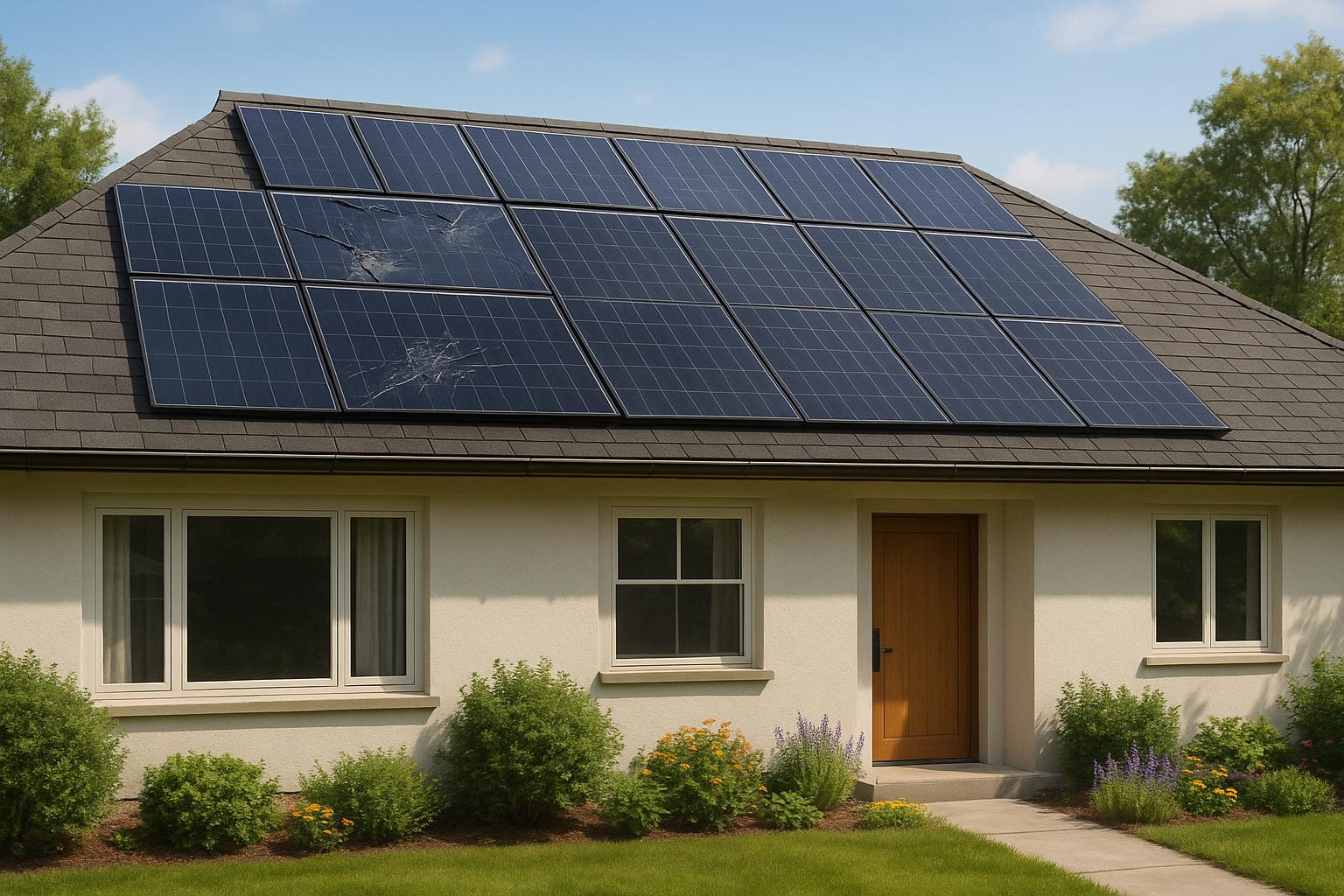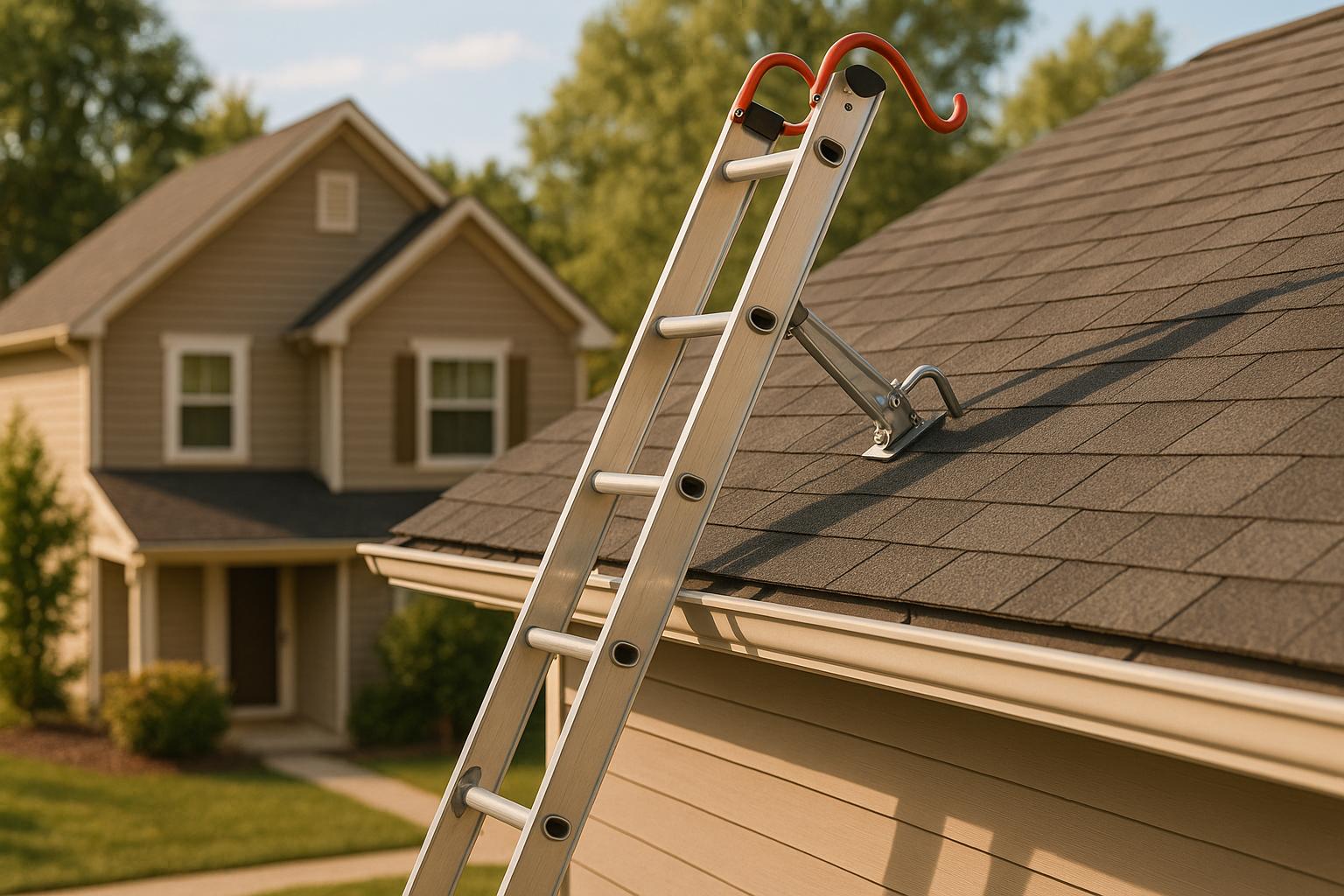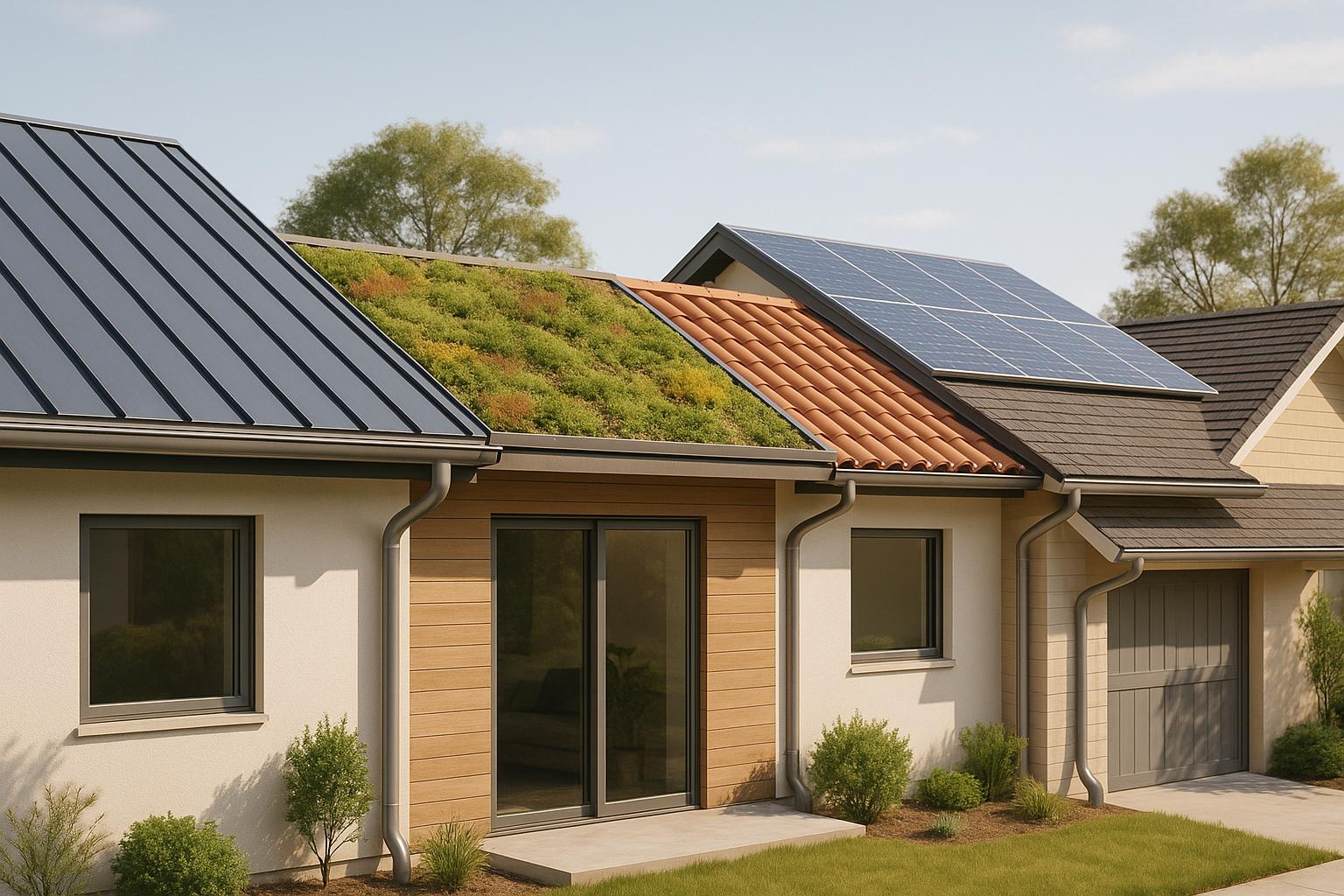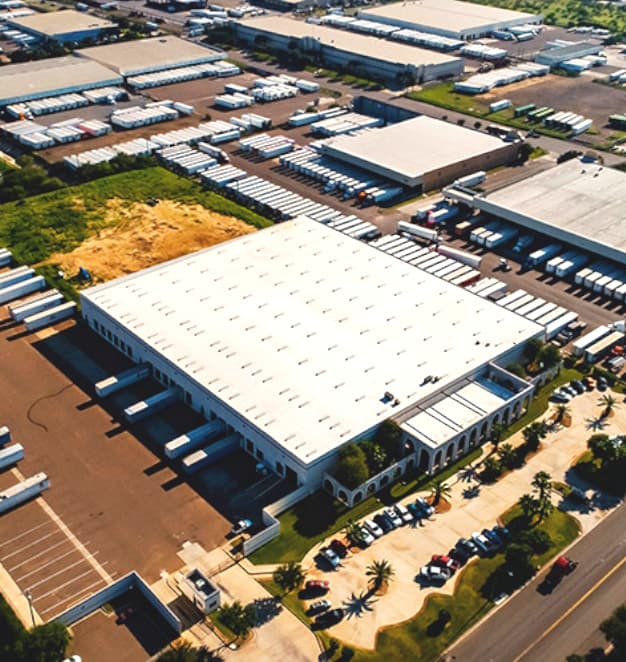Slate roofing is one of the most durable roofing materials available, with a lifespan ranging from 75 to 200 years depending on the quality of the slate and proper maintenance. In contrast, asphalt shingles last 15–30 years, and metal roofs last 40–70 years. Here’s what you need to know:
- Lifespan: Premium-grade slate can last over 100 years, while lower-quality slate may last 50–75 years.
- Durability: Slate is fireproof, moisture-resistant, and insect-proof, making it ideal for long-term protection.
- Maintenance: Regular inspections, quick repairs, and clean gutters can extend its lifespan.
- Cost: Slate roofs are expensive, costing $15–$40 per square foot, but their longevity often justifies the investment.
- Challenges: Heavy weight, fragile tiles, and the need for specialized installation are key drawbacks.
Quick Comparison of Roofing Materials
| Roofing Material | Lifespan | Cost per Sq Ft | Maintenance Needs | Durability |
|---|---|---|---|---|
| Asphalt Shingles | 15–30 years | $3–$7 | Moderate | Susceptible to weather wear |
| Metal Roofing | 40–70 years | $5–$14 | Low | May rust or corrode |
| Tile Roofing | 50–100 years | $10–$30 | Moderate | Durable but can crack |
| Slate Roofing | 75–200 years | $15–$40 | Low | Fireproof, moisture-proof |
If you’re looking for a roof that can last a lifetime (or more), slate is a great choice – but it requires professional installation and regular care to perform its best.
Slate Roof Types, Cost and Lifespan
How Long Slate Roofs Last
Slate roofs are known for their impressive longevity, typically lasting 75–100 years. Premium grades can even endure up to 200 years, making them one of the most durable roofing materials available. For comparison, asphalt shingles generally last 15–30 years, while metal roofs have a lifespan of 40–70 years. Some historic buildings showcase slate roofs that have exceeded 200 years, highlighting the material’s exceptional durability.
| Roofing Material | Typical Lifespan |
|---|---|
| Asphalt Shingles | 15–30 years |
| Metal Roofing | 40–70 years |
| Tile Roofing | 50–100 years |
| Slate Roofing | 75–200 years |
The lifespan of a slate roof depends heavily on the quality of the slate itself. According to ASTM standards, slate is graded as S1, S2, or S3. S1-grade slate offers the longest lifespan, exceeding 75 years. S2-grade slate lasts between 40 and 75 years, while S3-grade slate provides 20 to 40 years of service. Premium-grade slate, sourced from reputable quarries, is denser and more durable, with lower water absorption rates. This ensures lifespans that often surpass 100 years. The secret to slate’s longevity lies in its unique material properties, which are explored below.
What Makes Slate Roofs Last So Long
The exceptional durability of slate comes from its metamorphic composition, which makes it highly resistant to fire, mold, pests, and extreme weather conditions. Its density and low water absorption are key factors in preventing moisture infiltration, a common cause of roof deterioration. Unlike materials like asphalt shingles that can crack or lose granules, or metal roofs that may rust or corrode, slate retains its structural integrity for decades with minimal wear.
Welsh slate, often considered among the finest in the world, exemplifies these qualities. Its density and resistance to harsh weather enable it to endure over 100 years, even in regions with unpredictable climates. Maintenance for slate roofs is relatively simple, requiring only periodic inspections and occasional replacement of individual tiles to keep them in excellent condition throughout their extended lifespan.
What Affects How Long Your Slate Roof Will Last
A slate roof, when made from top-tier materials and installed properly, can endure for over a century. However, several factors influence whether it reaches that impressive lifespan. From the quality of the materials to the care it receives, every detail matters.
Material Quality
The type of slate used is one of the most important factors in determining how long your roof will last. High-grade S1 slate from reputable quarries can last anywhere from 100 to 150 years, while lower-grade slates may need replacement after just 50 to 75 years. Premium slate is denser, has fewer impurities, and is more resistant to wear and tear. On the other hand, lower-quality slate is prone to issues like flaking, cracking, and absorbing water. It may also contain pyrite, which can oxidize and weaken the material. Synthetic slate, while a more affordable option, typically lasts only 30 to 50 years. To maximize longevity, it’s essential to source high-quality slate and work with a skilled contractor.
Installation Quality
How your slate roof is installed is just as important as the materials themselves. Experienced professionals ensure proper techniques, such as even alignment, correct overlapping, and secure nailing. Mistakes during installation, like uneven placement or inadequate flashing, can lead to water leaks and weaken the roof’s structure over time. For this reason, DIY installation is highly discouraged. Proper installation not only enhances durability but also ensures the roof performs well under various conditions.
Climate and Weather
The environment plays a big role in how long a slate roof will last. While slate is naturally durable, extreme temperature changes and severe weather can take their toll. For instance, hailstorms, which are common in states like Texas, Nebraska, and Kansas, can cause cracks or surface damage. High humidity can also encourage moss and algae growth, which may harm the slate over time. Despite these challenges, with proper installation and ongoing care, a slate roof can still last for a century or more, even in tough climates.
Maintenance and Inspections
Routine maintenance and inspections are essential for prolonging the life of a slate roof. While slate requires less upkeep compared to other roofing materials, neglecting small issues can lead to bigger, more expensive problems. Regular inspections, especially in areas prone to harsh weather, can help identify potential concerns early on. Addressing these issues promptly not only saves money on repairs but also ensures your roof remains in excellent condition for decades.
How to Make Your Slate Roof Last Longer
Caring for a slate roof doesn’t demand constant effort, but a few targeted maintenance steps can go a long way in ensuring it lasts for decades. While slate roofs are known for their durability, proper upkeep is key to keeping them in top condition.
Get Regular Roof Inspections
Arrange for a professional roof inspection once a year – or twice if you live in an area with harsh weather conditions. In fact, some experts recommend biannual inspections in climates prone to extreme weather events like heavy snow or storms.
"Routine inspections are the key to a long-lasting slate roof. Experts recommend having a professional roofing contractor assess your slate roof at least once a year." – Roland Slate Service Co., Inc.
During these inspections, a roofing expert will look for cracked or missing tiles, check the flashings around chimneys and vents, and identify any potential water infiltration points. If your area experiences severe weather, like hail or heavy snow, don’t wait for your annual inspection – get your roof checked as soon as it’s safe. Prompt repairs and cleaning after inspections can help maintain your roof’s integrity.
Fix Damage Right Away
Don’t delay repairs when you spot damage. Whether it’s a cracked tile, a missing slate, or damaged flashing, addressing these issues promptly can prevent them from escalating into bigger, more expensive problems.
Water infiltration is a serious concern for slate roofs, as it can weaken the underlying structure and lead to costly repairs. Keep an eye out for red flags like cracked tiles, missing slates, water stains on ceilings, sagging rooflines, or corroded flashing around roof openings. If more than 20% of your slates are damaged, it might be time to consider replacing the roof entirely. Along with making quick repairs, keep your gutters and roof clear of debris to prolong your roof’s longevity.
Keep Gutters and Roof Clean
Clean gutters are a must for protecting your slate roof from water damage. Make it a habit to clean them twice a year to ensure proper drainage. Clogged gutters can cause water to back up under your slate tiles, leading to leaks and potential structural damage.
The roof itself also needs regular cleaning. Use a soft brush or a leaf blower to remove leaves, branches, and dirt that can trap moisture against the tiles. This trapped moisture encourages moss and algae growth, which can weaken the slate over time. For a deeper clean, use a gentle cleaning solution made specifically for slate roofs and a soft-bristle brush once or twice a year. Steer clear of pressure washing – it can damage the tiles and push water into places it shouldn’t go.
Don’t forget about nearby trees. Trim overhanging branches to reduce shade and dampness, as these create ideal conditions for moss and algae to thrive. Regular cleaning and tree maintenance not only protect your roof but also help you catch small problems early, making them easier and less costly to fix.
sbb-itb-d1d6490
Pros and Cons of Slate Roofing
Building on the durability factors discussed earlier, let’s dive into the specific advantages and challenges of slate roofing. While slate roofs offer numerous benefits, they also come with their share of challenges.
Benefits of Slate Roofing
Incredible Longevity is one of slate’s standout features. A properly installed slate roof can last for decades, often outliving the homeowners themselves, with minimal need for replacement.
Fire Resistance is another major perk. Slate is completely fireproof, which can provide peace of mind and potentially save on damage repair costs. For perspective, repairing fire and smoke damage can cost around $4,172, while water and wind damage averages $2,386 and $5,757 respectively.
Minimal Maintenance is a big plus. Once installed, slate roofs require only routine inspections and occasional cleaning, unlike other materials that may need frequent repairs or replacement.
Eco-Friendly Appeal makes slate a popular choice for environmentally conscious homeowners. As a natural material, slate can be recycled or reused. The National Slate Association highlights that "A slate roof’s longevity alone makes it an environmental plus". Trent Cotney from Cotney Law adds, "Slate is also the best ecological choice".
Boost in Property Value is another benefit. Slate roofs can provide a return on investment (ROI) ranging from 60% to 85%, significantly enhancing both the market value and curb appeal of a home.
Exceptional Durability protects against a variety of threats. Slate is naturally resistant to mold, fire, and insects, and its density helps maintain temperature stability inside the building.
Drawbacks of Slate Roofing
High Initial Costs can be a dealbreaker for some. Installing a slate roof typically costs between $15.00 and $40.00 per square foot, which is at least four times the cost of asphalt shingles. For comparison, asphalt shingles run $3 to $7 per square foot, while natural slate tiles range from $10 to $30 per square foot.
Heavy Weight poses structural challenges. With some slate roofs weighing around 800 pounds per square foot, a structural evaluation is often necessary. John Chan, CEO of The Durable Slate Company, advises, "Make sure you have your roofing contractor and/or an engineer inspect your structure before replacing your roof with slate if it’s not currently slate".
Installation Difficulties make finding experienced contractors a challenge. Proper slate installation requires specialized skills, and mistakes are common. According to John Chan, "80% of the new slate roofs I’m called out to inspect have installation problems, improper head lap, improper side lap, or incorrect nailing".
Fragility During Handling is another concern. Slate tiles can easily break if not handled correctly, and replacing individual tiles can cost between $50 and $200.
No Material Warranty leaves homeowners without manufacturer protection. Since slate is a natural material, it typically doesn’t come with a warranty.
Color Matching Issues can complicate repairs. Due to natural variations in slate’s color, finding an exact match for damaged tiles can be challenging, potentially affecting the roof’s overall appearance.
Benefits vs. Drawbacks Comparison
| Benefits | Drawbacks |
|---|---|
| 75-200+ year lifespan | High upfront cost ($15-$40/sq ft) |
| Completely fireproof | Heavy weight (800 lbs/sq ft) |
| Low maintenance needs | Requires specialized installation |
| 60-85% ROI potential | Fragile tiles break easily |
| Environmentally friendly | No material warranty |
| Resistant to mold, insects, fire | Difficult color matching for repairs |
| Natural beauty and variety | Limited qualified contractors |
Deciding on slate roofing ultimately depends on your budget, long-term goals, and priorities. While the initial investment is steep, the roof’s longevity and low maintenance demands often make it a practical choice when compared to materials that may need replacement every 15–30 years. This breakdown highlights why professional expertise plays a crucial role in ensuring a successful slate roof installation.
Why You Need Professional Help
Installing a slate roof isn’t just another home improvement project – it’s a highly specialized craft that demands expertise. Mistakes during installation or repairs can lead to expensive problems, threatening both the roof’s integrity and its longevity.
John Chan, CEO of The Durable Slate Company, highlights that many slate roofs fail due to installation errors. These errors can result in water leaks, structural damage, and a shorter roof lifespan, all of which undermine the value of your investment.
Safety is another critical factor. Working with slate tiles isn’t just tricky – it’s dangerous. The tiles are fragile, and the surfaces can be slippery, making DIY repairs a risky venture without the right tools, training, and experience.
Professional help also saves money in the long run. Labor accounts for 40% to 50% of the total cost of a slate roof, and hiring skilled contractors ensures the job is done right the first time. In areas like Southern California, where the climate brings intense sun and heavy rain, experienced contractors can recommend installation and maintenance practices that protect your roof from weather-related damage. They also conduct routine inspections to catch issues like nail sickness, tile misalignment, or delamination before they escalate into costly repairs.
In short, professionals don’t just install slate roofs – they help preserve your investment for years to come.
Prime American Roofing Services
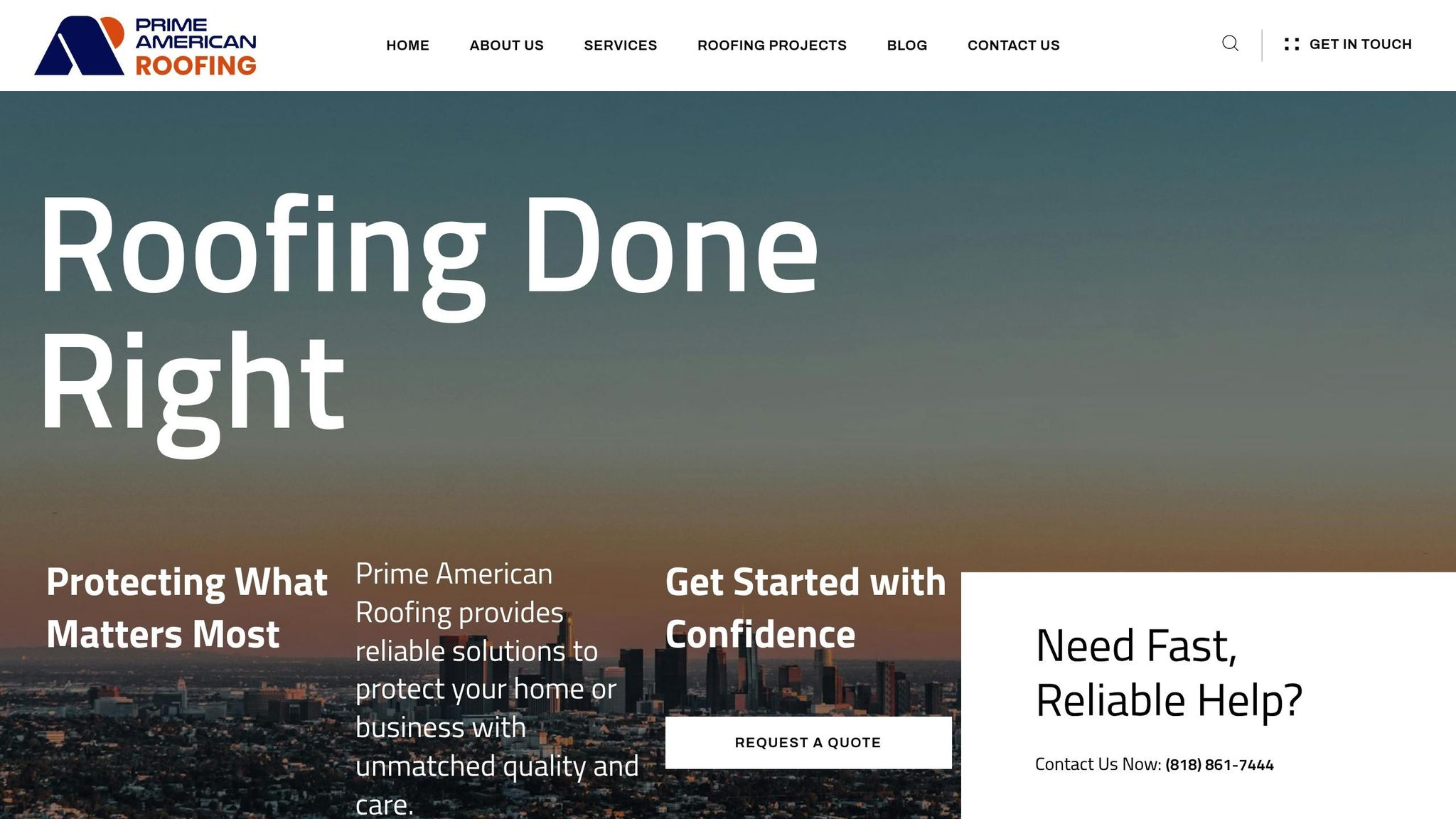
Prime American Roofing is a trusted name in slate roofing across Los Angeles and Southern California. Founded by Tony Mirzakhanyan, the company has a deep understanding of the unique challenges that slate roofs face in this region’s climate.
Their services cover all aspects of slate roofing, from expert installation to thorough inspections and skilled repairs. Recognizing the precision that slate roofing demands, they offer free initial inspections to evaluate your roof’s condition and identify potential problems before they become expensive headaches.
With a focus on Southern California’s specific weather patterns – like harsh sun exposure and heavy rains – Prime American Roofing customizes their installation and maintenance techniques to ensure your roof lasts as long as possible.
At the heart of their work is a commitment to quality. Slate roofing is a significant investment, often lasting over a century, and Prime American Roofing uses only top-tier materials and proven techniques to minimize common issues like poor alignment or premature wear.
They also provide fast emergency response services, giving you peace of mind when unexpected damage occurs. Their expertise in slate-specific repairs ensures that minor problems don’t spiral into major ones, all while keeping customer satisfaction a top priority.
Conclusion
Slate roofing stands out as one of the most durable options available, with a lifespan ranging from 75 to 200 years when properly installed and maintained. This durability makes it a smart choice for homeowners in Southern California, where intense sunlight and occasional heavy rains demand a roof that can handle decades of exposure.
The type of slate plays a big role in its longevity. For instance, premium S1-grade slate can last 100 to 150 years, while lower-grade materials may need replacement after just 50 to 75 years. Combine high-quality materials with precise installation techniques, and you’ve got a roof that can reach its full potential. However, achieving this requires regular maintenance and prompt attention to repairs.
Simple upkeep – like cleaning gutters and scheduling regular inspections – can add years to your roof’s life. Beyond that, slate roofs may even boost your property value by 5% to 10%. But caring for slate isn’t something to leave to chance. Its specialized requirements mean that professional expertise is crucial. From proper installation to spotting early signs of wear, skilled professionals ensure your roof performs as intended, turning a decades-long investment into a lifetime of protection.
For homeowners in Los Angeles and across Southern California, Prime American Roofing provides the expertise needed to make the most of your slate roof. Their services cover everything from expert installation to routine maintenance and emergency repairs, ensuring your investment is well-protected and your roof delivers the lasting performance it’s built for.
FAQs
What factors influence how long a slate roof lasts?
The durability of a slate roof hinges on a few critical factors: correct installation, the grade of the slate, exposure to weather elements (such as storms, intense heat, or freeze-thaw cycles), and the structural integrity of the roof itself. Consistent maintenance also plays a major role in keeping it in excellent condition and preventing small issues from escalating.
When installed properly and using top-grade slate, these roofs can last well over 100 years. Regular inspections and prompt repairs are key to ensuring your slate roof remains sturdy, even under tough weather conditions.
Is slate roofing worth the higher upfront cost?
When it comes to slate roofing, the upfront cost is undeniably higher than many other options, typically falling between $20 and $35 per square foot. For a 2,500-square-foot roof, that’s around $50,000 to $87,500. But here’s the thing – its incredible lifespan and durability make it a worthwhile long-term investment. High-quality slate can last more than 100 years, and in some cases, premium grades can endure for up to 200 years. That’s far beyond what most other roofing materials can offer.
Another bonus? Slate roofs require very little maintenance, which means you’re not constantly shelling out for repairs or replacements. While the initial price tag might feel steep, the combination of its longevity and low upkeep often leads to significant savings over time. For anyone looking for a roofing solution that stands the test of time, slate is a solid and dependable choice.
What maintenance steps can help a slate roof last its full lifespan?
To ensure your slate roof stands the test of time, regular upkeep is essential. Schedule inspections twice a year, preferably in spring and fall, to catch and address issues like cracked, loose, or missing slates. Tackling these problems early can help you avoid water leaks and potential structural damage.
It’s also important to keep your gutters and downspouts clear. Proper drainage prevents moisture buildup, which can otherwise encourage moss growth and gradually weaken the roof. With consistent inspections, timely repairs, and effective drainage management, a slate roof can endure for 75 to over 200 years when cared for properly.

